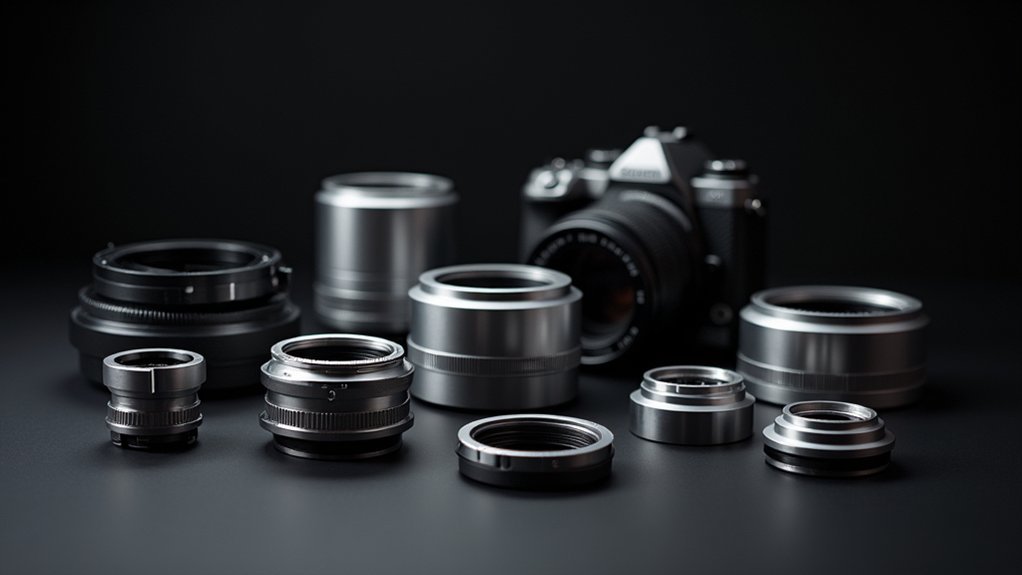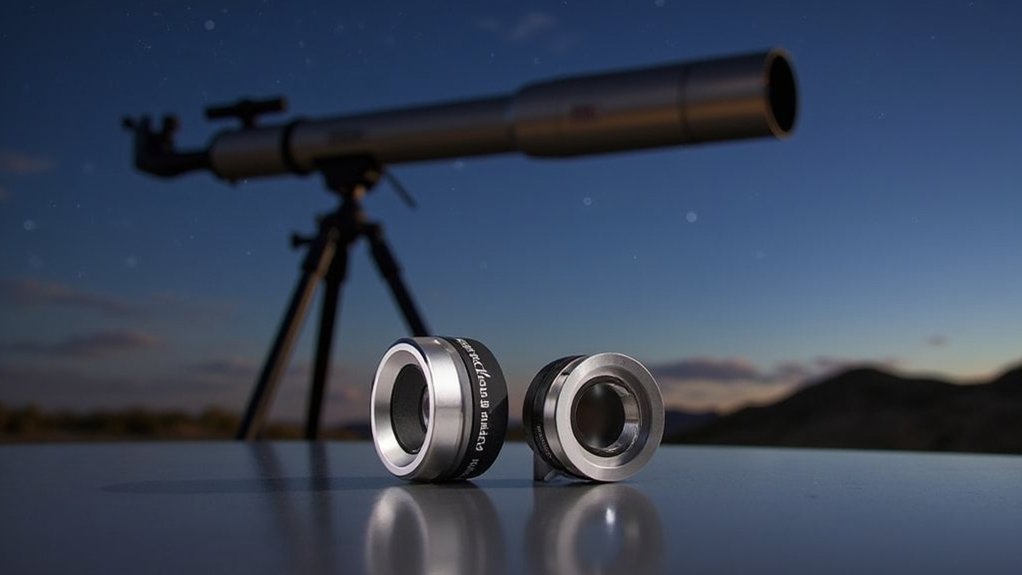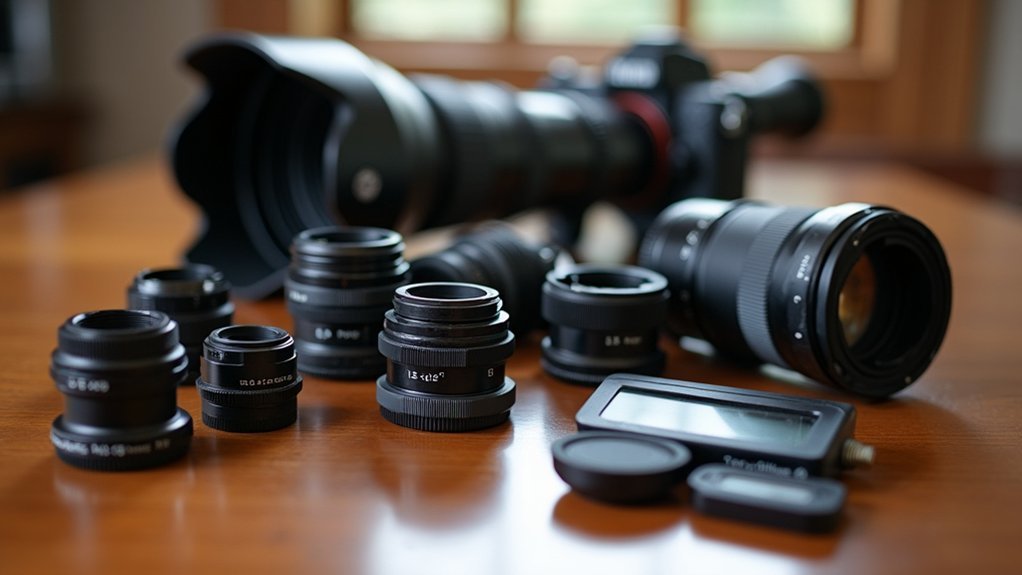Telescope adapters vary based on your camera type. DSLRs need brand-specific T-rings plus T-adapters that match your telescope’s eyepiece diameter (typically 1.25″ or 2″). Mirrorless cameras require special adapters with shorter back-focus distances. Smartphones work with universal clamp adapters that attach to eyepieces. Always verify compatibility between your camera mount, telescope model, and desired imaging method. The right connection makes all the difference between frustration and capturing stunning celestial images.
Understanding Telescope-to-Camera Connection Basics

The bridge between stargazing and astrophotography lies in proper equipment connection.
When you’re ready to capture celestial objects, you’ll need specialized camera adapters that connect your specific camera model to your telescope tube. These adapters aren’t universal—a Canon EOS requires a different T-ring than a Sony E-mount camera.
Proper back focus is critical for successful imaging. Your adapter must position your camera’s sensor at precisely the right distance from the telescope’s focal plane. Without correct spacing, you’ll struggle with vignetting and focus issues across your image.
Most adapters are designed for standard 1.25″ or 2″ eyepiece holders. Before purchasing, verify compatibility with both your camera mount type and telescope’s eyepiece size to guarantee a secure, properly aligned connection that will deliver sharp, full-frame images.
Types of Camera Adapters for Different Telescope Models
Different telescope models require specific adapters to connect with your camera equipment effectively.
You’ll find dedicated options for DSLRs with T-rings and brand-specific bayonet mounts, while mirrorless systems often need shorter back-focus adapters to achieve proper infinity focus.
For casual astrophotography, smartphone adapters offer a convenient solution that allows you to align your phone’s camera with the telescope eyepiece without specialized mounting hardware.
DSLR Connection Options
When connecting your DSLR camera to a telescope, you’ll need specific adapters that match both your camera brand and telescope model. T-rings are brand-specific components that attach to your camera body, while T-adapters connect to your telescope’s focuser, creating a Prime Focus setup for direct imaging.
| Adapter Kit | Brand | Price |
|---|---|---|
| Prime Focus Kit | Canon EOS/Rebel | $39.00 |
| Prime Focus Kit | Nikon SLR/DSLR | $39.00 |
| Custom Adapters | Sony/Others | Varies |
Ensure you select the correct combination for your equipment to maintain proper back focus and alignment. This pairing determines your imaging capabilities and final image quality. For smartphone users, specialty adapters are also available, expanding your astrophotography options beyond traditional DSLR setups.
Mirrorless System Compatibility
Mirrorless cameras have revolutionized the astrophotography landscape with their compact designs and advanced sensor technologies. Unlike DSLRs, these systems require specific adapter configurations to properly connect with telescope focusers.
For Sony users, the E Mount Prime Focus Kit provides an ideal solution, maintaining proper back focus for crisp astronomical imaging.
Canon’s EOS-M photographers will need the dedicated Mirrorless Prime Focus Kit designed specifically for their mount system.
When selecting a camera adapter for your mirrorless setup, pay close attention to the telescope focuser’s diameter.
The T42 Camera Adapter works effectively with T-thread compatible mirrorless bodies while minimizing vignetting on full-frame sensors.
Always verify your adapter combination provides sufficient clearance and alignment to achieve proper focus and field coverage with your telescope.
Smartphone Adapter Solutions
Why limit your astrophotography to traditional cameras when your smartphone can capture stunning celestial images? Smartphone adapters bridge the gap between your mobile device and telescope, transforming your everyday phone into a powerful astrophotography tool.
These specialized mounts securely hold your device while properly aligning its camera with your telescope’s eyepiece.
- Universal clamp systems – Adjustable grips accommodate various phone sizes from compact models to larger devices, ensuring a stable connection regardless of your smartphone brand.
- Precision alignment adapters – Designed to perfectly align your phone’s camera with the telescope’s optical axis for crisp, focused images.
- Compatible mounting options – Different adapters work with specific telescope models, so choose one that’s compatible with your particular setup for best results.
T-Ring and T-Adapter Compatibility Guide
When selecting a T-ring for your telescope setup, you’ll need to match it precisely with your camera brand’s bayonet mount to guarantee proper attachment and functionality.
Your T-adapter must complement both your telescope’s focus tube diameter and provide appropriate spacing to achieve correct backfocus, which directly impacts your ability to reach focus with celestial objects.
Remember that insufficient backfocus can prevent focusing on distant objects, while excessive spacing might limit your ability to focus on closer terrestrial subjects.
T-Ring Brand Compatibility
For successful astrophotography, understanding the specific T-ring requirements for your camera brand is crucial. Your camera’s mounting system determines which T-ring you’ll need, as each manufacturer uses a proprietary lens mount design.
Using the wrong T-ring will prevent proper attachment or could damage your equipment.
- Canon cameras require Canon-specific T-rings that match their EF or RF mount systems.
- Nikon users must select T-rings designed for F-mount or Z-mount compatibility.
- Sony cameras need distinct T-rings for A-mount or E-mount systems.
When selecting your adapter setup, always verify both the T-ring compatibility with your camera brand and its compatibility with your telescope’s T-adapter.
Many manufacturers offer branded kits that guarantee perfect alignment between components, eliminating potential focus issues or vignetting in your astrophotography images.
Spacing and Backfocus Essentials
Beyond selecting the right T-ring for your camera brand, understanding proper spacing and backfocus distances represents the next key factor in building an effective astrophotography system.
Your T-adapter must pair correctly with your telescope model to maintain the precise back focus needed for sharp images. When these measurements are off, you’ll likely encounter vignetting and focus issues that compromise your shots.
T-rings and T-adapters work together to create this ideal spacing, ensuring your camera sensor sits at the exact distance needed from your telescope’s focal plane.
For fine-tuning this distance, consider adding spacers to your setup, especially when switching between different camera models with varying sensor sizes.
This customization helps you achieve the perfect back focus for crisp, clear astrophotography results every time.
Prime Focus vs. Eyepiece Projection Methods

Choosing between prime focus and eyepiece projection methods depends primarily on your imaging goals and the celestial objects you’re targeting.
Prime focus photography offers wider fields and better light transmission by connecting your camera directly to the telescope using T-rings and T-adapters, making it ideal for deep-sky objects with minimal optical distortion.
Eyepiece projection, on the other hand, magnifies your subject by positioning your camera above an eyepiece, which works well for planetary imaging despite potential field curvature.
- Equipment Requirements: Prime focus needs only T-rings and T-adapters, while eyepiece projection requires specialized holders for both camera and eyepiece.
- Image Quality: Prime focus delivers clearer, wider-field images with better light capture.
- Application: Use prime focus for galaxies and nebulae; choose eyepiece projection for planets and lunar details.
Smartphone and Mirrorless Camera Mounting Solutions
Adaptability stands at the heart of modern astrophotography, with specialized mounting solutions now enabling both smartphones and mirrorless cameras to transform into powerful celestial imaging tools. You’ll find universal smartphone adapters that securely clamp your device to telescope eyepieces, allowing for quick adjustments while maintaining alignment.
For mirrorless cameras, you’ll need T-rings specific to your camera’s mount, paired with appropriate T-adapters for your telescope model. These create a secure, direct connection for peak focus.
| Device Type | Adapter Required | Key Benefits |
|---|---|---|
| Smartphone | Universal clamp | Fits multiple phones |
| Smartphone | Eyepiece mount | Easy alignment |
| Mirrorless | T-ring | Camera-specific fit |
| Mirrorless | T-adapter | Direct telescope connection |
| Either | Lightweight design | Improved stability |
Balancing Weight Considerations for Camera Adapters

While mounting solutions create the connection between your camera and telescope, proper weight balance determines your imaging success. Heavy camera adapters require focuser locks to maintain stability and prevent focus drift during your imaging sessions.
Without proper balance, your telescope’s tracking capabilities may suffer, causing unwanted movement in your field of view.
- Check total weight – Combine your camera and adapter weight to verify your telescope’s focuser can handle the load, especially for video astronomy setups.
- Consider focuser design – Cassegrainian telescopes often offer robust focusers that accommodate heavier equipment without compromising performance.
- Evaluate balance solutions – If your adapter-camera combination is too heavy, you’ll need longer dovetail bars to properly distribute weight and maintain stability.
Regular equipment alignment checks are essential when using heavier adapters to guarantee peak performance.
Choosing the Right Adapter for Your Imaging Goals
How will your specific imaging goals impact your adapter selection? If you’re pursuing prime focus imaging, you’ll need T-rings and T-adapters specifically designed for your camera brand—whether Canon, Nikon, or Sony.
These adapters guarantee proper back focus, which is essential for peak image quality.
For mobile astrophotography, consider smartphone adapters that align with your particular model.
When selecting a camera adapter, remember that full-frame cameras require adapters that prevent vignetting with your telescope’s focal plane.
Detail-oriented planetary imaging might benefit from the precision alignment of adapters like the Baader Microstage II, while deep-sky photography demands adapters that maintain stability during long exposures.
Always match your adapter to both your telescope model and camera type to achieve your desired astrophotography results.
Frequently Asked Questions
How Do I Connect My Camera to My Telescope?
You’ll need a T-ring specific to your camera brand and a T-adapter that fits your telescope’s focuser. Attach the T-ring to your camera, connect it to the T-adapter, and secure in the telescope.
How Do I Use My Phone as a Telescope Adapter?
You’ll need a smartphone telescope adapter that securely clamps your phone to the eyepiece. Position your camera lens over the eyepiece, adjust for clarity, then use your phone’s camera app to capture images.
Can You Turn a Camera Lens Into a Telescope?
Yes, you can turn your camera lens into a telescope by mounting it backward on your camera or using T-adapters. Telephoto lenses work best, especially when paired with proper mounts and teleconverters for astronomical viewing.
Can You Attach a DSLR to a Celestron Telescope?
Yes, you can attach your DSLR to a Celestron telescope using a T-ring specific to your camera brand and a T-adapter. This prime focus setup turns your telescope into a powerful telephoto lens for astrophotography.
In Summary
You’ll need to match your adapter to both your telescope and camera for successful astrophotography. T-rings are camera-specific, while T-adapters connect to your telescope’s eyepiece holder. Consider whether prime focus or eyepiece projection better suits your imaging goals. Don’t forget about weight distribution when mounting heavier DSLRs. With the right adapter combination, you’re ready to capture the cosmos with your existing equipment.





Leave a Reply